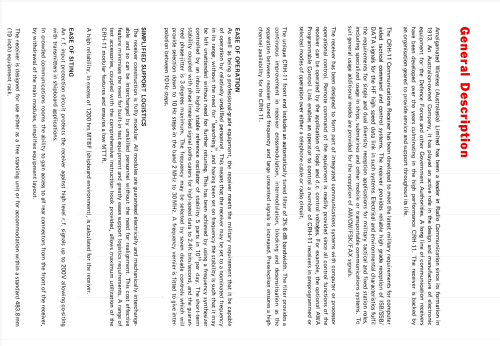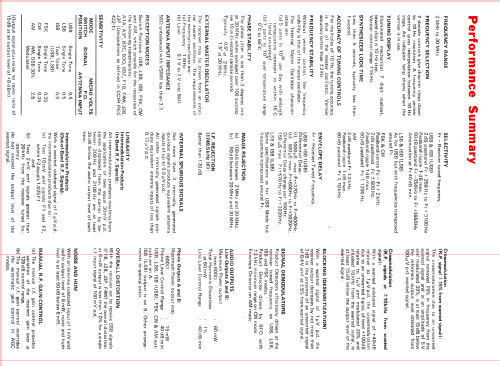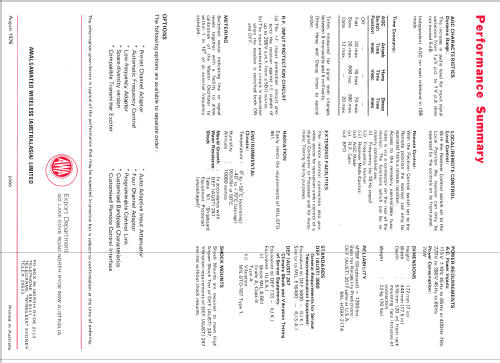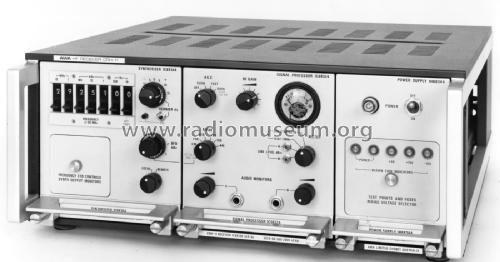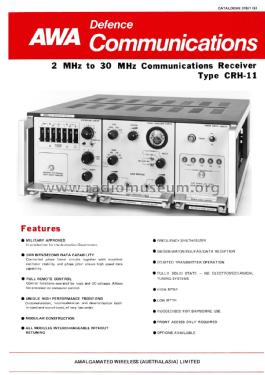HF Receiver CRH-11 1C68300
Amalgamated Wireless (Australasia) Ltd. (AWA); Sydney
- Paese
- Australia
- Produttore / Marca
- Amalgamated Wireless (Australasia) Ltd. (AWA); Sydney
- Anno
- 1975–2000
- Categoria
- Ricevitore militare
- Radiomuseum.org ID
- 321954
Clicca sulla miniatura dello schema per richiederlo come documento gratuito.
- Numero di transistor
- A semiconduttori.
- Semiconduttori
- Principio generale
- Supereterodina con stadio RF; ZF/IF 1749.5 kHz
- Gamme d'onda
- Onde corte (solamente OC)
- Tensioni di funzionamento
- Alimentazione a corrente alternata (CA) / 115V or 220-260 Volt
- Altoparlante
- - Questo apparecchio richiede altoparlante/i esterno/i.
- Materiali
- Mobile di metallo
- Radiomuseum.org
- Modello: HF Receiver CRH-11 1C68300 - Amalgamated Wireless
- Forma
- Rack
- Dimensioni (LxAxP)
- 444 x 177 x 516 mm / 17.5 x 7 x 20.3 inch
- Annotazioni
-
The CRH-11 HF synthesised communications receiver designed from 1972 and released in 1975 was developed to meet the latest military requirements for computer aided tactical command and control systems. The receiver provides reliable high-grade reception of ISB/SSB/DATA signals for HF high speed data links in military systems. Electrical and environmental characteristics fulfil the requirements for single and dual diversity reception applications for military tactical and fixed station roles,
including specialised usage in ships, submarines and other mobile or transportable communications systems.
To suit general usage additional modes were provided for the reception of AM/CW/FSK/FAX signals.
The receiver front end incorporated an automatic tuned filter of 3% 6 dB bandwidth. This filter provides a continuous improvement in receiver crossmodulation, intermodulation, blocking and desensitisation as the separation of receiver tuned frequency and large unwanted signals. This preselection results in high channel availability.
The radio assembly is comprised of three plug-in modules in rack mounted case.
- 1C68304 Synthesiser for frequency control via 7 thumbwheel switches, BFO and local/ remote control selection
- 1C68324 Signal processor for control of RF gain, AGC delay, audio monitoring, signal strength meter and Mode selection
- 1H68344 Power Supply
In 1972, Jim Spence BSc(Elec. Eng.) was appointed Project Engineer, managing eight engineers with the task of designing a new 2 to 30 MHz HF receiver for the Royal Australian Navy (RAN) that met some parts of an equivalent US Military Specification (MIL-SPEC) that no US supplier had yet met at that time. The task took three years and involved multiple prototypes and many months of radio performance, testing under a broad range of environmental conditions. Jim also made many visits to the USA to discuss various aspects of the MIL-SPEC with US experts who considered it to be just a design target unlike the RAN who considered it a mandatory requirement. The receiver known as the CRH-11 went into production in 1975 and remined in service into the early 2000’s.
Two examples of the CRH-11 are on display in the radio room of HMAS Gladstone at the Gladstone Maritime museum.
- Peso netto
- 32 kg / 70 lb 7.8 oz (70.485 lb)
- Bibliografia
- - - Manufacturers Literature (AWA Deference Communications, Cat 318/E)
- Autore
- Modello inviato da Gary Cowans. Utilizzare "Proponi modifica" per inviare ulteriori dati.
- Altri modelli
-
In questo link sono elencati 1431 modelli, di cui 874 con immagini e 463 con schemi.
Elenco delle radio e altri apparecchi della Amalgamated Wireless (Australasia) Ltd. (AWA); Sydney
